



Exhibition Tour and Artists Talk (Magnus Eriksson and Geraldine Juárez)
Saturday 03 May 2014, 2pm
Exhibition tour led by Magnus Eriksson and Geraldine Juárez followed by a live walk-through of the Piratbyrån archive and talk about some overlooked gems from their history at Furtherfield Commons. Expect to learn some Swedish while we are at it!
SEE IMAGES FROM THE PRIVATE VIEW
Contact: info@furtherfield.org
Curated by Rachel Falconer & Furtherfield
EXHIBITION TRAILER – Piracy as Friendship
@Furtherfield “Don’t contact future. Future will contact you!”
“For the last sixty years, capitalism has been running a pretty tight ship in the West. But in increasing numbers, pirates are hacking into the hull and the holes are starting to appear. Privately owned property, ideas, and privileges are leaking into the public domain beyond anyone’s control.” – Matt Mason, The Pirate’s Dilemma
Piratbyrån and Friends traces the stories of cultural sharing and affinity-building among the activities and values of the members of Piratbyrån (The Bureau of Piracy). This Swedish artist/activist group was established in 2003 to promote the free sharing of information, culture and intellectual property. The exhibition presents screenings, installations and artworks by founding and more recent members, keen to tell the story of the group on their own terms. It features newly commissioned work by artists Geraldine Juarez and Evan Roth, and a new networked audio collaboration which mediates their rich archive and foregrounds the role of piracy as an agent of innovative disruption and cultural transmission.

“The specific character of friendship as a form of social relationship is that it does not presume a permanent interaction. Friendships are a type of serial solidarity. The story of friendship is a story of meetings.” Viktor Misiano – The Institutionalization of Friendship.
Piratbyrån have always resisted clear definition. Created on the Internet as a loose friendship group with a shared commitment to media and piracy in the shifting ecologies of digital copyright law, Piratbyrån operated through a number of different identities. From the #discobeddienti IRC chatroom, to the infamous Pirate Bay, to the determinedly analogue SX23 bus trip to Manifesta 7, and their subsequent disbandment in 2010, Piratbyrån consciously cultivated an air of mystery and intrigue around their many activities.
Piratbyrån have always had a particular commitment to the value of friendship as a shelter for culture and a space to understand, imagine and experiment as a community from the edges of the Internet.
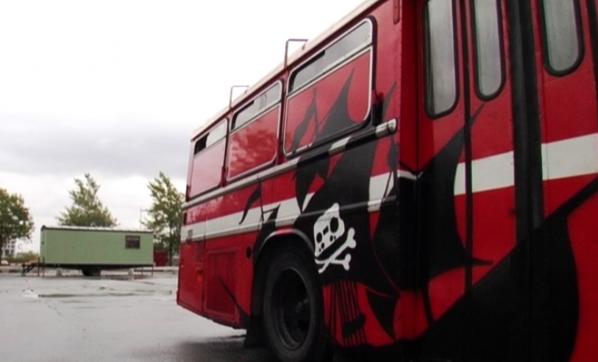
The exhibition features newly commissioned sculptures and installations by artists James Cauty, Geraldine Juárez and Evan Roth and a screening programme that includes Steal This Film by Jamie King and Piratbyrån and Friends by Geraldine Juarez.
Tapecasts (2013-2014) – Piratbyrån and Friends
SK23 Suit (2008) – Lina Persdotter Carlsson / Piratbyrån
S23m Manifesta Bus Trip (2008) – Piratbyrån & Simon Klose
S23x Belgrade Bus trip (2008) – Piratbyrån
Polymarchs posters (1980-1990) – Jaime Ruelas
Sharing is Caring Map (2008) – Sara Wolfert / Mathias Tervo / Piratbyrån
Kopimi Totem (2014) – Evan Roth
Torrent Tent (2014) – Geraldine Juárez
Riot Chat (2014) – Palle Thorsson
Smiley Riot Shield 2 (Second Edition) and PB2 (2014) – James Cauty
Piratbyrån (The Bureau for Piracy) was started by a bunch of hacking, coding, reading, listening, philosophising, clubbing, rioting, carding, chatting, loving, slacking people in 2003 as an antidote to Hollywood’s representatives in Sweden – Antipiratbyrån.
In 2007 – after having kickstarted the Swedish debate over file-sharing, which by the time had become a major issue in the previous years national election and after having created The Pirate Bay as a side-project that became the world largest file-sharing system – the people from Piratbyrån had grown tired of the file-sharing debate and its endless repetitions of for-or-against, legal-or-illegal, payment-or-gratis. At the last day of April in a Walpurgis fire on the top of the highest mountain in Stockholm the masked members burned the remaining copies of a book on file-sharing they had published some years earlier and declared the debate dead. The video documentation of this ritual, set to the soundtrack of KLF’s “What Time is Love”, found its way to the Indian Raqs Media Collective group who was just about to curate the next Manifesta biennial in Bolzano, Italy.
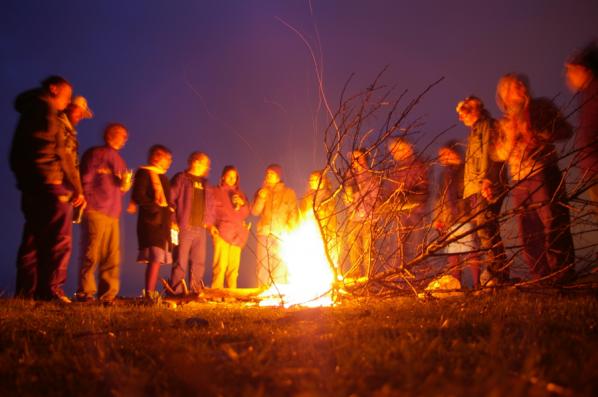
The loose network of Piratbyrån, now loaded with 7000 Euros of art budget and a sizable amount of cash from selling Pirate Bay t-shirts, decided to purchase, renovate and decorate a 1970s city bus, stack it with 23 people, and head down south.

The ongoing relation with the bus – named S23m/x/k respectively for each trip – would later make an exodus from the exhibition in Italy to head across Eastern Europe and end up at the trial against Pirate Bay. It became one of the most significant undertakings of Piratbyrån and shaped their thoughts on the tensions between digital abundance and crowded space, collective decisions and freedom of choice, and that which can be copied and that which can’t. The bus became a line of flight from the collective subject that had been built, a subject which was very associated with The Pirate Bay and also with Swedish politics, including the Pirate Party.
While nothing was really the same after the bus had returned, Piratbyrån formally lasted until 2009, when the tragic death of one of the founding members – Ibi Kopimi Botani – defined the end of an era. The Internet had already transitioned to another phase and it is not until now, and enough time has passed, that we as a culture are ready to reflect on what exactly happened during those years.
Piratbyrån always had an implicit friendship with the KLF. They share the same historical web of connections and share a similar trajectory, but their activities are shifted in time by roughly a decade. The only contact between the two is a response from Bill Drummond when Piratbyrån sent a link to the documentation of the Walpurgis ritual. It read:
> Thank you for your email.
> I have just read the text at the link.
> I enjoyed it and understood it.
It is probably good that they didn’t exist at the same time because the gap in time gives the relation an infinite unresolvable tension of unfulfilled connectivity and unlimited possibilities.
James Cauty
For Piratbyrån, James Cauty’s personal work resonates with the themes of abundance and rarity, presence and absence, functionality and waste, control and chaos, and draws on the same symbolic language that mixes clarity with suggestion. There is also a similar urge to *stir things up* and *stick ones nose where it doesn’t belong*.
Evan Roth
Speaking of stirring things up, FATLAB was for Piratbyrån another one of those instantly recognisable friends that had never met; the art group that Piratbyrån never became, the “the unsolicited viral marketing wing of the open-source movement”, the graffiti crew of the World Wide Web. FATLAB was born when the file-sharing debate was buried and the new web 2.0 era transformed the web.
Evan Roth, co-founder of FATLAB, has made a piece for the exhibition that in a subtle but direct way captures the concept of KOPIMI; how meetings and connections leave traces and makes you a carrier of ideas and information, sometimes without you even recognising it.
Jaime Ruelas & Polymarchs
The soundsystem collective Polymarchs and their illustrator Jaime Ruelas, probably happily unaware of the existence of Piratbyrån, embodies a scene in Mexico where piracy has always been a way of life and a mode of existence. They have materialised, expressed and lived what was only hinted at in glowing screens up in Sweden. Having outlasted all of the above mentioned collectives and managed to stick together for decades, they also highlight both the potential strength and – as a contrast – the fragility of so called “confidential projects”; those moments when friendships turn into expressive units and the borders between the intimate and the public are blurred.
Geraldine Juárez
Last but not least, Geraldine Juárez is the reason this exhibition came together at all. She began to read the Swedish-language blogs of Piratbyrån members through Google translate – whose mistranslations made them sound like they came from the near future instead of the near past, until she finally came into contact with Piratbyrån by translating updates from the trial – or Spectrial, as it was known – into Spanish. Now she returns the favor of time-travelling by re-awakening Piratbyrån one last time, to allow their archive to again live up, their ideas to be carried over to others and perhaps even some sense made from what happened, although these things can only be interpreted, misunderstood and re-appropriated – never explained.
Inside the tent that she has crafted for the exhibition – a torrent for piracy as the last shelter of culture – there will be a collection of tapes prepared and circulated by Piratbyrån and friends, perhaps giving some seed for thoughts and guidance in the process of excavating the archive of Piratbyrån.
About co-curator Rachel Falconer
Rachel Falconer is a curator, writer and producer working at the intersections of technology, the media and contemporary art. She currently holds the position of Head of Art and Technology at SPACE and runs the art and technology programme at The White Building and SPACE MediaLab. She is Co-Editor at Furtherfield and a founding member of the collective Hardcore Software.
Her curatorial practice is hybrid and interdisciplinary in approach and her current activity and research focuses on the pathologies surrounding social spaces and human behaviours engaged with networks and new technologies.
Furtherfield Gallery
McKenzie Pavilion, Finsbury Park
London N4 2NQ
T: +44 (0)20 8802 2827
E: info@furtherfield.org
Furtherfield Gallery is supported by Haringey Council and Arts Council England
Contact: info@furtherfield.org
Furtherfield Gallery is pleased to host One Minute Volume 7, a new series of shorts curated by filmmaker Kerry Baldry. The screening is accompanied by One Minute Remix, a selection of moving images from One Minute Volumes 1-5.
One Minute Volume 7 is the latest in the edition of One Minute artists’ moving image programmes curated by artist and filmmaker Kerry Baldry, and includes an eclectic mix of artists’ moving image constrained to the time limit of one minute. The One Minute programmes have been screened at numerous galleries, artists spaces and film festivals worldwide.
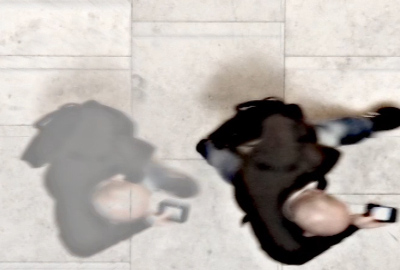
Volume 7 includes work by John Smith, Rose Butler, Tony Hill, Steven Ball, Alexander Costello, Leister/Harris, Kayla Parker and Stuart Moore, Louisa Minkin, Claire Hope, Max Hattler, Guy Sherwin, Steven Woloshen, Lynn Loo, Lumière and Son, Tansy Spinks, Gary Peploe and Peter Nutley, Eva Rudlinger, Michael Szpakowski, Zhel (Zeljko Vukicevic) , Matthias Kispert, Stuart Pound, Sellotape Cinema, Alex Pearl, My Name Is Scot, Kerry Baldry, Esther Johnson, Marty St. James, Nicki Rolls, Katherine Meynell, Chris Paul Daniels, Riccardo Iacono, Edwin Rostron, Martin Pickles, Grant Petrey, Annabel Dover, Kelvin Brown.
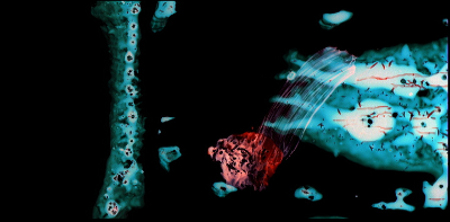
One Minute Remix (a selection from One Minute volumes 1 – 5) was originally compiled by Kerry Baldry for a screening as part of Kayla Parker and Stuart Moore’s moving image event ‘Welcome to The Treasure Dome’ (in a ICCI 360 Arena, which displayed audiovisual/moving image artwork via 5 projectors, with the screens arranged in a ‘seamless’ circle wrapped around the inside of a 21-metre diameter dome, and with surround sound) on behalf of ICCI (Innovation for the Creative and Cultural Industries) with Plymouth University; part of Maritime Mix – London 2012 Cultural Olympiad by the Sea programme, Weymouth (10 and 11 August 2012).

The programme includes work by Martin Pickles, Alex Pearl, Steven Ball, Gordon Dawson, Michael Szpakowski, Virginia Hilyard, Barry Lewis, Nick Jordan, Claire Morales, Nicki Rolls, Kerry Baldry, Riccardo Iacono, Eva Rudlinger, Zhel (Zeljko Vukicevic), Esther Johnson, Sam Renseiw and Philip Sanderson’s Lumière & Son, Katharine Meynell, Stuart Pound, Kayla Parker and Stuart Moore, Ron Diorio, Daniela Butsch, Guy Sherwin, Louisa Minkin, Rose Butler, Dave Griffiths.
+ More information: http://oneminuteartistfilms.blogspot.co.uk/
Produced by Furtherfield.
Kerry BaldryKerry Baldry is an artist/filmmaker who works in a range of media including film and video. She is a Fine Art Graduate from Middlesex University who went on to study film and video at Central St. Martins. Her first commissioned film was to make a film for BBC2’s One Minute Television which was broadcast on The Late Show – a joint collaboration between BBC2 and Arts Council England.
Over the last 6 years, aside from producing her own work, she has been curating, promoting and distributing a self initiated, unfunded project titled One Minute, One Minute Volume 7 being the latest in the edition. One Minute Volumes 1-7 are an eclectic mix of artists moving image constrained to the time limit of one minute and includes over 80 artists at varying stages of their careers.
Furtherfield Gallery
McKenzie Pavilion, Finsbury Park
London N4 2NQ
T: +44 (0)20 8802 2827
E: info@furtherfield.org
Furtherfield Gallery is supported by Haringey Council and Arts Council England.
DoggieWoggiez! PoochieWoochiez! is a new video work (2012) by Everything is Terrible!, a self-described “found footage chop shoppe”. DoggieWoggiez! PoochieWoochiez! is an active catalog which describes, invents and destroys concepts as it arranges video footage into flows of multiple cuts that map the use of dogs in cinema and television. The structure of this review takes hints from the work it overlays. We dispensed with “original” writing and didactic detailing of what we as critics experienced. Instead, we unraveled multiple threads left hanging after watching DoggieWoggiez! PoochieWoochiez! We neglected to offer an appraisal of the worth of the work, and add to the number of words already in the world. Instead, we traced the flows passing through the video and developed a program of citations that provide a map of exit and entrance points-a map, as any map, that is as much about those making as about the territory described-which we hope will provide openings for a reader who has not yet watched the work, and provide expanded intersections for those who already have.
“This is the scenario: You are terminally ill, all medical treatments acceptable to you have been exhausted, and the suffering in its different forms is unbearable. Because the illness is serious, you recognize that your life is drawing to a close. Euthanasia comes to mind as a way of release.” 1
“Success consists of simply getting up one more time than you fall.” 2
“From whatever angle you approach it, the present offers no way out. This is not the least of its virtues. From those who seek hope above all, it tears away every firm ground. Those who claim to have solutions are contradicted almost immediately. Everyone agrees that things can only get worse. ” 3
“A positive anything is better than a negative nothing.” 4
“I think it’s because dog movies and dog footage tends to be the dumbest. It’s like the lowest common denominator amongst everything we’ve found, the most mediocre footage imaginable. I think that was a big motivator, and we just like dogs. It’s a nicer way to deliver horrible things about humanity. Instead of watching people be racist, which makes you feel terrible, you get to watch dogs be racist, and you’re like, ‘That’s a little better.'” 5
“Americans spent $50.96 billion on their pets in 2011. That’s an all-time high, and for the first time in history more than $50 billion has gone to dogs, cats, canaries, guppies and the like, the American Pet Products Association reports. Food and vet costs accounted for about 65 percent of the spending. But it was a service category one that includes grooming, boarding, pet hotels, pet-sitting and day care that grew more than any other, surging 7.9 percent from $3.51 billion in 2010 to $3.79 billion in 2011.” 6
“So we have a corpse on our backs, but we won’t be able to rid ourselves of it just like that. Nothing is to be expected from the end of civilization, from its clinical death. In and of itself, it can only be of interest to historians. It’s a fact, and it must be translated into a decision. Facts can be conjured away, but decision is political. To decide on the death of civilization, then to work out how it will happen: only decision will rid us of the corpse.” 7
2:39 . Black and white footage of a clothed dog sleeping in hay.
2:41 . Saint Bernard laying on the floor trying to drink champagne out of a bottle.
2:42 . Black and white footage of a dog holding a bottle labeled “Hard Cider” in his mouth and drinking.
2:43 . Dog with bandana sitting at table licking the foam from a beer.
A hand pouring beer into a dish filled with dog food.
2:44 . A club. Multiple young women filling the face of a puppet dog full of liquor bottles.
2:45 . A dog wearing a jersey with the number one peeing on a referee’s ankle.
2:47 . A dog lifting its leg on a pants suit leg.
A bulldog in a spiked collar peeing on a floor mat that says “I [heart] Acting.”
2:48 . A dog peeing on a metal catwalk, shot from below.
2:49 . Jack Nicholson holds a small dog up and away from his chest as the dog pees.
A man lying on a floor is shot below and through a dogs legs, the dog’s urine stream is hitting him in the face.
2:51 . A similar shot, reversed. Another man, wearing a fur hat, is buried to his neck in sand and ice. A dog urinates into his mouth.
2:51 . The same bulldog in spiked collar lifts his leg to pee. A small rocket comes out of from beneath him.
2:52 . A similar shot from the other side, a different dog is urinating flames.
“I am for an art that embroils itself with the everyday crap & still comes out on top.” 8
“Trash collection is the business of public sanitation; its recycling, the very height of capitalist alchemy, turns everything into grist for commodification’s mill. But it is also a strategy of aesthetic sublimation that, according to Thomas Crow, is internal to modernism (he has analyzed the cyclical aspect of this in terms of the incorporation of the ‘low’ by the ‘high’)” 9
“Classification in the widest sense is, along with astronomy, probably one of the oldest scientific pursuits undertaken by man. In the most general terms classification is the process of giving names to a collection of objects which are thought to be similar to each other in some respect. The ability to sort similar things into categories is obviously a primitive one, since it would seem to be a prerequisite of the development of language, which consists of words which help us to recognize and discuss the diSerent types of events, objects and people we encounter; each noun in a language is a label used to describe a class of things which have striking features in common. Thus for example, we name animals as cats, dogs, or horses and such a name collects individuals into groups.” 10
“I am for an art that imitates the human, that is comic, if necessary, or violent, or whatever is.” 11
“What is it that moves over the body of a society? It is always flows, and a person is always a cutting off [coupure] of a flow. A person is always a point of departure for the production of a flow, a point of destination for the reception of a flow, a flow of any kind; or, better yet, an interception of many flows.” 12
“I am for the art of things lost or thrown away, coming home from school.” 13
“Cluster analysis, also called data segmentation, has a variety of goals. All relate to grouping or segmenting a collection of objects into subsets or “clusters,” such that those within each cluster are more closely related to one another than objects assigned to different clusters. An object can be described by a set of measurements, or by its relation to other objects.” 14
“And now, we have to start from scratch with this movie and go through thousands of VHS tapes and find those three minutes and put them in a pile until we have enough to make an hour-long movie. And yeah, it made it harder because we just fucking hate those movies.” 15
“Central to all of the goals of cluster analysis is the notion of the degree of similarity (or dissimilarity) between the individual objects being clustered. A clustering method attempts to group the objects based on the definition of similarity supplied to it.” 16
“[Claes Oldenburg] quickly saw that it didn’t take anything to make a Ray Gun: any right angle would suffice, even blunted, even barely perceptible. The Ray Gun is the ‘universal angle’: ‘Examples: Legs, Sevens, Pistols, Arms, Phalli-simple Ray Guns. Double Ray Guns: Cross, Airplanes. Absurd Ray Guns: Ice Cream Sodas. Complex Ray Guns: Chairs, Beds. Mondrian didn’t need to reduce everything to the right angle: everything is already a right angle. During the time of The Store, Oldenburg made huge numbers of Ray Guns (in plaster, in papier mache, in all kinds of materials in fact), but he soon saw that he didn’t even need to make them: the world is full of Ray Guns. All one has to do is stoop to gather them from the sidewalks (the Ray Gun is an essentially urban piece of trash: Oldenburg produced their anagram as Nug Yar:New York). Even better: he didn’t even need to collect them himself; he could ask his friends to bring them to him (he limited himself to accepting or refusing the find’s addition into the corpus, according to purely subjective criteria). Finally, there are all the Ray Guns one can’t move- splotches on the ground, holes in the wall, torn posters-but which one could photograph. The “inventory”is potentially infinite. And what should be done with this invasive tide? Put it in the museum.” 17
“I am for the art out of a doggy’s mouth, falling five stories from the roof.” 18
2:54 . A dog and man lay side-by-side. The dog’s legs are up and its belly is exposed to the camera. Voiceover: “Being a thief isn’t bad enough, you have to be a lush too.”
2:56 . A golden retriever puppy faces the camera with a drunken expression. The dogs lips move as he says “That’s the weirdestest grape juice ever.” He laughs.
3:02 . A dog jumps off a large desert rock onto another rock. He yells “Hasta la vista, kitty.” A mountain lion is shown launching into the air.
3:05 . Maniacal laughter is played over footage of a tree frog sitting on the top of a dog’s head.
3:06 . A Weimaraner sleeps under a blanket. Voiceover: “Do dogs dream? She dreams she’s a dear”
A ripple dissolve into the same dog with her head stuck through a tapestry of deer so that it appears that there is a deer with a dog head.
“Are there Oedipal animals with which one can ‘play Oedipus,’ play family, my little dog, my little cat, and then other animals by contrast draw us into an irresistible becoming? Or another hypothesis : Can the same animal taken up by two opposing functions and movements, depending on the case?” 19
“Writing about the dog who befriended him and his fellow-inmates in a concentration camp, and whom they named Bobby, Levinas says that this dog was ‘the last Kantian in Nazi Germany,’ because his joyful greetings reminded the prisoners of their human dignity. Yet, when questioned closely about the ethical status of nonhuman animals, Levinas is reluctant to ascribe to animals that ‘ethical face’ which he elsewhere has called (as Martin calls Sylvia’s face) ‘an epiphany.’ By contrast, says Levinas, the animal face is merely ‘biological,’ incapable of demanding the ethical response. Levinas denies that the dog can have a face in the ethical sense: ‘the phenomenon of the face is not in its purest form in the dog,’ he writes. ‘I cannot say at what moment you have the right to be called ‘face.’ The human face is completely different and only afterwards do we discover the face of the animal.’ In an article subtitled ‘Levinas Faces the Animal,’ Peter Steeves, with gentle irony, stages another face-to-face encounter between Levinas and Bobby, asking the philosopher: ‘What could Bobby be missing? Is his snout too pointy to constitute a face? Is his nose too wet? Do his ears hang low, do they wobble to and fro? How can this not be a face?'” 20
“We’ve always had a thing with how people treat little people at Everything Is Terrible!, like it’s really weird and creepy. Anybody who’s like a second-class being, when they’re used in videos, it comes across very creepy and gross. I think it’s the same thing with humans and dogs. They’re weirdly sexualized, they’re weirdly turned into little kids at the same time.” 21
“…individuated animals, family pets, sentimental, Oedipal animals each with its own petty history, ‘my’ cat, ‘my’ dog. These animals invite us to regress, draw us into a narcissistic contemplation, and they are the only kind of animal psychoanalysis understands, the better to discover a daddy, a mommy, a little brother behind them (when psychoanalysis talks about animals, animals learn to laugh): anyone who likes cats or dogs is a fool.” 22
“I think that’s a big reason why people use dogs the way they do, because I think we kind of hate ourselves so we dress up dogs like ourselves to mock ourselves. So you dress a dog up like a drunk human, and then you laugh at how ridiculous it is, but I think it’s therapeutic. We’re letting off steam about how much we hate ourselves.” 23
3:13 . A close-up of a shaggy dog who speaks. “It’s not a dream”.
3:16 . A large dog outside a car tells a small dog inside a car, “Bitches ain’t got no business being inside your head” The voice is or is similar to Samuel Jackson’s.
3:17 . A bloodhound with an ice pack on its head also has cartoon dream bubbles floating around it. The woman inside the bubbles says, brightly “Wake up!”
Another dog, turning his head to the camera, says “Who are those jokers?”
Return to the bloodhound, the floating woman says “It’s me, Jan.”
3:20 . A dog dressed as a pauper is grabbed from above and dragged to the side.
A dog wearing a bandana says “Great danes! This is terrible. But what can I do…”
This trails into a golden retriever saying “…I’m a dog.”
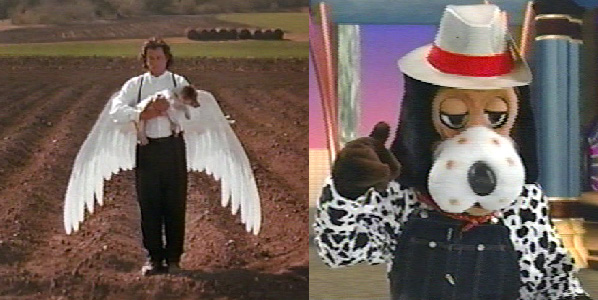
“What difference does it make if someone is terminal? We are all terminal.” 24
layla commented: 4-21-2008 9:01 PM “In 2007 Guillermo Vargas Habacuc a so called artist took an abandoned dog from the streets tied him to a very short rope to a wall in an art gallery and left a kettle of food on the other side of the room beyond his reach and left him there to slowly die of hunger and thirst. The socalled artist of such cruelty and the visitors of the gallery of art watched the agony of this animal. The dog finally died of famine surely after a painful absurd and incomprehensible torture. The prestigious Centralamerican Biennial of Art decided that this horrible act committed by this guy was art and Guillermo Vargas Habacuc has been invited to repeat his cruel actions in said Biennial in 2008. i seen this post on facebook and a few pictures of the poor innocent dog starving to death it broke my heart and i had to see if peta was aware of this sick man who thinks this i some great at creation.” 25
olivia commented: 5-10-2008 5:35 PM “i hate you. you should be put in the poor dog’s possision. you can’t imagine how many people hate you. almost more than a million. just so you know thats not art. the dog died because of you. you should go to prison because of this. you broke peoples’ hearts. i am really upset at you i could write all day long if i have to because you just waisted a life i wish i could waiste youres!!!!!! do you wish all the animals should die? you just made my day so so so horrible. im going to tell everyone what you just did. just so you know i’m cring. i hate hate hate hate you. you should be ashamed of your self. so listen to this just because you think your all that doesn’t mean that you can kill an other animal. i have 7 animals and you are not going to touch them! that dog did nothing to you. if heshe did doesn’t mean you should kill him! please don’t touch any other animal!!!!!! you suck!!!!!!!!!!!!!!!!!!!!!!!!!!!!!!!!!!!!!!!!!!!!!!!!!!!!!!!!!!!!!!!!!!!!!!!!!!!!!!!!!!!!!!!!!!!!!!!!!!!!!!!!!!!!!!!!!!!! P.s i hate youuuuuuuuuuuuuuuuuuuuu” 26
Renate commented: 5-5-2008 1:34 PM “Here’s a thought let’s tie up Guillermo Vargas at one of his own exhibits and starve him to death!” 27
Rainie M commented: 4-28-2008 2:59 PM “Oh Gods! How can anyone be so bloody heartless? Dead or dying animals are NOT art…things like this only come from sick minds. Is the human race devolving so much that we have come down to this as entertainment? If you want Art go to a Museum . Geez this is just sick…” 28
Tucker commented: 4-26-2008 10:43 AM “THIS IS DOWN RIGHT UNCALLED FOR DIGUSTINGCRUEL AND THESE PEOPLE NEED TO BE LOCKED UP AND CHARGED BIG TIME!!!!!!!!!!!!!!!!!!!!!!!!!!!!!!!!!!!!!!!!!!!!!!!!!!!!!!!!!! I AM CRYING SO HARD RIGHT NOW IT IS UNBELIEVABLE WHAT $IN PEOPLE DO TO ANIMALS AND THIS ALL NEEDS TO STOP NOW AND BIG TIME CHARGES AND JAIL TIME NEED TO BE STRONGER AND LONGER IN ALL STATES AND AROUND THE WORLD!!!!!!!!!!!!!!!!!!!!!!!!!!!!!!!!!!!!!!!!!!!!!!!!!!!!!!!!!!!!!!!!!!!!!!!!!!!!!!!!!!!!!!!!!!!!!!!!!!!!!!!!!!!!!!!!!!!!!!! SAVE THE ANIMALS!!!!!!!!!!!!!!!!!!!!!!!!!!!!!!!!!!!!!!!!!!!!!!!!!!!!!!!!!!!!!!!!!!!!!!!!!!!!!!!!!!!!!!!!!!!!!!!!!!!!!!!!!!!!!!!!!!!!!” 29
Angie commented: 4-24-2008 12:55 PM “I am so sickend by this whole so called art.. I am a artist myself. ! And i think someone need to tie this guy up and not feed him any food and have people watch him starve . Then he will realize how it feels. He gives a bad name to other artist out there!” 30
yf commented: 4-22-2008 2:32 PM “you know he really shoudl have starved himself and then do a ‘selfportrait’.. much more apt.. silly stupid man.. so pointless.. so banal.. people KNOW what skeletal skin and bones animals look like .. we have seen them.. we know what skeletal starved humans look like too infact.. we dont’ need a dumb dimwit 12 brained idiot to INTENIONALLY starve a dog in ORDER to produce his pointless ‘artwork’.. what a dumb stupid peabrained twit !” 31
Kristin Gleeson commented: 4-22-2008 1:29 AM “Yeah I’ve seen something like this before but what was it? Oh yeah the HOLOCAUST. Thousands of people collected subdued and starved to death. Was that an artistic masterpiece? If you call this art you’d have to call Hitler an artist I mean after all he was trying to make a culturally altering statement as well. It’s not art it’s sadistic immoral and completely disgusting. This poor creature did not deserve this and neither does any other animal on the planet.” 32
“Do not imitate a dog, but make your organism enter into composition with something else in such a way that the particles emitted from the aggregate thus composed will be a canine as a function of the relation of movement and rest, or of molecular proximity, into which they enter.” 33
“Its efficiency is striking. There is nothing extra, superfluous or obscure about Mr. Kulik’s performance. For all intents and purposes, he is a dog: he can be scary and unpredictable and territorial. After all, he’s in his prime, about 5 dog years old; visitors who wish to enter his cage may do so one at a time and must put on the quilted overalls and arm-guards that hang near the chained and barred door to his cage.” 34
“The choice of the term ‘pack’ for this older and more limited kind of crowd is intended to remind us that it owes its origin among men to the example of animals, the pack of animals hunting together. Wolves, which man knew well and from whom many of the dogs he uses derive, had impressed him very early. Their occurrence as mythical animals among so many peoples, the conception of the were-wolf, the stories of men who, disguised as wolves, assailed and dismembered other men, the legend of children brought up as wolvesall these things and many others prove how close the wolf was to man.” 35
“Saying it would be too confusing, a judge has denied the petition of a so-called ‘furry’ to legally change his name to Boomer the Dog. Forty-four-year-old Green Tree resident Gary Guy Mathews says he filed for the name change in June because he’s a fan of a short-lived 1980s NBC television series called “Here’s Boomer,” which featured a dog that rescued people.” 36
Where’s Waldo, #1.5 – Sun Aug 15, 2010 10:31 PM EDT “This boy ain’t wired right. I’ve heard of men wanting to be a women and women wanting to be men but this is a new one on me. Mom and Dad must have raised the poor kid in a kennel instead of a crib. Wonder what his favorite pup food was? Of course maybe he’s smarter than any of us thinks……or maybe not.” 37
dave-735909, Thu Aug 12, 2010 10:21 AM EDT “Why can’t we just respect people’s constitutional right to be crazy?” 38
Susi-Oh, Thu Aug 12, 2010 12:10 PM EDT “My sentiments exactly but how far do you want to take this? Should we just let him bark back when you ask him a question? Can you introduce a guy like that with a straight face? He’s big for a dog and might scare little children. Actually, even without the name change he looks a bit scary.” 39
Janet A., #15 – Thu Aug 12, 2010 10:59 AM EDT “If this idiot was truly a dog, we’d put him to sleep for being insane. Just a thought.” 40
wchall1949, #2 – Thu Aug 12, 2010 10:15 AM EDT “OMG – the really frightening thing here is that this guy is allowed to marry & reproduce!!! Truly scary!! What a moron!!!” 41
Sues-343312, #2.1 – Thu Aug 12, 2010 11:22 AM EDT “Well he is 44 yrs old has managed to not procreate up to now. Let’s just hope he meets up with a spayed female” 42
3:26 . A close-up of a crying child, with a dissolve of snow over his face. He says “Daddy…”
Close up of an adult man, he says “I don’t have a daddy.”
A girl wears a party hat. Lying on her bed, she talks to her brother, also wearing a party hat. She says “I just miss him so much…”
Cut to a different girl in pigtails addressing a bloodhound wearing a king’s crown and fur cape. She says “I miss him too.”
3:30 . Close-up of a crying boy. “I miss him, mom.”
Angry-looking farmer standing under a tree. He says “Your mother passed on.”
3:32 . A woman lays on a bed with a girl. “…to join the angels.”
A man looks up to the sky and gestures upwards “She’s in heaven.”
A woman with a party hat “watching over you right now.”
3:37 . A boy addresses a dog. “My dad used to do that.”
A boy and his mother talk as she drives. The boy says “He wants a dad.”
A woman sits next to a boy outside with a rocky hill behind them. He is looking through binoculars. She says “You remind me a lot of your dad sitting there.”
“When they’re your best friend it turns into this weird, gross, furry pile where you can’t tell where the lines are between human and dog, master and slave, and sex, and it’s just ugh.” 43
“Bestiality lowered a man to the level of a beast, but it also left something human in the animal.” 44
“A man has appeared before Limerick District Court charged with ordering his Alsatian dog to have sex with a 43-year-old mother of four, who died from an adverse allergic reaction to the intercourse.” 45
“Addressing the consent issue, Daniels writes, ‘[T]he truth is that animals, particularly domesticated ones, don’t consent to most of the things that happen to them.’ Animal sexual autonomy is regularly violated for human financial gain through procedures such as AI. Such procedures are probably more disturbing physically and psychologically than an act of zoophilia would be, yet the issue of consent on the part of the animal is never raised in the discussion of such procedures. Should the day Bentham speaks of arrive when animal rights are recognized by society and the law, an argument which speaks only to the zoophile’s right to fair exercise of his property rights in the animals he owns may prove an insufficient legal justification for acts of zoophilia.” 46
“In 1812 in a similar case in strongly Federalist Seneca County, New York,William Moulton, a fifty-eight-year-old veteran of the Revolutionary War and a prominent Democratic-Republican, was accused of buggering a bitch, which then delivered a litter of puppies that ‘had large heads, no hair on them nor tails, and on the side of their head they had small ears.'” 47
“I am for the majestic art of dog-turds, rising like cathedral.” 48
“The right of sovereignty was the right to take life or let live. And then this new right is established: the right to make live and to let die.” 49
“Though a single gull had already struck Melanie on the forehead the day before, the choice of the children’s party for this first fully choreographed attack suggests the extent to which the birds take aim at the social structures of meaning that observances like the birthday party serve to secure and enact: take aim, that is, not only at children and the sacralization of childhood, but also at the very organization of meaning around structures of subjectivity that celebrate, along with the day of one’s birth, the ideology of reproductive necessity.” 50
“Death is outside the power relationship. Death is beyond the reach of power, and power has a grip on it only in general, overall or statistical terms…death now becomes, in contrast, the moment when the individual escapes all power, falls back on himself and retreats, so to speak, into his own privacy. Power no longer recognizes death. Power literally ignores death.” 51
“Physician assisted suicide is fundamentally inconsistent with the physician’s professional role.” 52
“Even worse their comments continue to make no distinction between hierarchical and non-hierarchical organizations and institutions — simply rejecting all organization — which is tantamount, if you think about it for a minute, to proposing a future that lacks workplaces, religious centers, families, any kind of assemblies, and so on — a future in which lone individuals or small groups fend for themselves (a vision seemingly not too far from what they propose).” 53
‘It is critical that the medical profession redoubles its efforts to ensure that dying patients are provided optimal treatment for their pain and other discomfort. The use of more aggressive comfort care measures, including greater reliance on hospice care, can alleviate the physical and emotional suffering that dying patients experience. Evaluation and treatment by a health professional with expertise in the psychiatric aspects of terminal illness can often alleviate the suffering that leads a patient to desire assisted suicide.” 54
“Their vision of a commune offers very little guarantee of its own basic existence. There are no proposed methods for deciding what will be produced or consumed nor how much of each or its distribution in a socially responsible way.” 55
“The euthanasia of animals has been acknowledged by most animal protection organizations, including [The Humane Society of the United States], as an appropriate and humane means of ending the suffering of an animal in physical distress. It is also used widely to end the lives of animals who have severe behavioral problems, including aggression, and cannot be adopted into an appropriate new home because they pose a threat to the health and safety of people or other animals.” 56
“Once we know where it is we want to go, we can then act with the urgency needed to organize and build institutions and movements able to win change and create the necessary foundations for a future society.” 57
“Those who demand another society should better start to realize that there is none left. And maybe they would then stop being wannabe-managers.” 58
“This is the dog’s real trick, the height of animal acting. Not surprisingly, the imitated action is one of violence and must have been somewhat complicated; because all pet dogs, and dog performers most of all, must be nonviolent and cooperative, the animal actor here must go against its ‘nature’ in order to successfully set up the final tableau. That animals can be domesticatedmade to forego violence in order to serve peopleis the triumph of human culture over nature. That they can then be trained to appear violentto attack humansis the ironic confirmation of this subjection.” 59
“Should you battle on, take the pain, endure the indignity, and await the inevitable end, which may be days, weeks or months away? Or should you take control of the situation and resort to some form of euthanasia, which in its modern-language definition has come to mean ‘help with a good death’?” 60
“At the final stage of this evolution, we see the first socialist mayor of Paris putting the finishing touches on urban pacification with a new police protocol for a poor neighborhood, announced with the following carefully chosen words: ‘We’re building a civilized space here.’ There’s nothing more to say, everything has to be destroyed.” 61
3:43 A montage of eerily smiling children’s’ faces. Audio is the word “dad” played over and over as it overlaps and becomes “dog”. The words dad and dog are repeated in a loop. The video becomes a distorted montage of psychedelic faces of children and dogs. Eventually the words dad and dog becomes god.
4:03 The montage audio and video end abruptly.
A small dog says “I know something we can do.”
A shot of a Bernese, who says “Poop” then winks.

DoggieWoggiez! PoochieWoochiez! $20
http://www.everythingisterrible.bigcartel.com/product/doggiewoggiez-poochiewoochiez
http://www.everythingisterrible.com/
Featured image: Radion at NetAudio London festival 2011.
NetAudio London Festival, 13th – 15th May 2011.
A three day festival that explores music environments in the digital age of networked technologies. http://www.netaudiolondon.org/
Marc Garrett interviews Andi Studer of NetAudio London, about their latest Festival at the Roundhouse and other venues in London, from Friday 13th – 15th May 2011. Showcasing work of artists who use digital and network technologies to explore new boundaries in music and sonic art, their festivals encourage participation in all forms: interactive sound art installations, conferences, workshops, collaborative online broadcasting and headline shows. This year promises to be a special event, headlined by the legendary Nurse With Wound and many more – read on.
Marc Garrett: This seems like an amazing festival. Not just because it’s context relates to my own background and Furtherfield’s own connected communities and its history in exploring an engagement of contemporary, networked creativity which was once perhaps, considered to be at the edge of art. But now, it does seem as if a new passion is alive and kicking, representing what exists across the genres of art, technology and social change.
The Netaudio London festival began its life in 2006, why did you chose to set up such a dynamic and involving festival, and who are your influences?
Andi Studer: The first Netaudio London grew out of a general passion for electronic music, combined with the recognition of a booming netlabel scene distributing new music with CC licenses for free download. Culturally it spanned the three fields of club culture, avant-garde music and net-politics. During the research phase, we came across of string of European festival projects with the same scope and decided to align with them, so after Netaudio Berne and Cologne, in 2005, London took it’s turn in 2006. Over 3 days we presented more than forty acts in club as well as gig settings; we hosted cultural discussions, organised a knowledge fair around digital music distribution and premiered an the audio installation by Si_COMM, S.E.T.I and N-Spaces… good old days!
MG: What do you feel is important about the Netaudio festival and how does the current one relate to contemporary culture?
AS: Netaudio aims to play an active role in the ongoing process of exploring how technologies, and particularly the Internet, shape our lives. Within this vast field, we focus our work on sonic culture, music and sound art, but reach out to wider aspects such as politics and protest or collaborative creativity.
Whereas in 2005/06 much of the cultural discussion was driven by an incredible optimism about new communication and distribution channels, this year’s festival may pick up on something best described as ‘cyber realism’. The festival, and particularly the conference, building on our 2010 research project, presents a strong case for individuals taking action. And in process of so doing, we are interested to explore what emerging digital tools they use to create new sound art/music, as well as in the social and political endeavours related to their creative work.
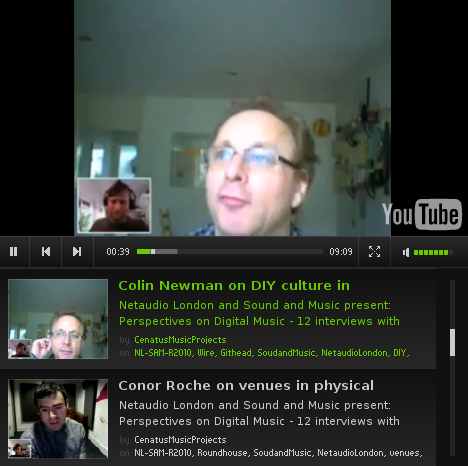
MG: Why chose to include those who have a history in net art, critically engaged thinkers invlolved in networked culture, and many who have been and are part of the (new) media art generation?
AS: We recognise a continuation of creative and socially aware work, enabled by network technologies. Including emerging as well as established projects, some dating from well before the WWW time, allows us to show this continuation and hopefully furthers the wider understanding of these different elements/groups. Whilst there are clear differences between them, there are also many overlaps and we hope that the inclusion of as many as possible in the debate and the wider festival allows for an exploration and greater understanding of these overlaps, and differences.
MG: Your festival includes a visiting member from UK Uncut who will be discussing with others at the Conference and Workshops, regarding the proposed theme of ‘politics and protest; creativity and collaboration; digital futures and analogue survivals.’ They have made headline news regarding their activities challenging the government’s ongoing cuts, and have been actively involved across the country targeting corporate tax dodgers and the banks who caused the financial crisis.
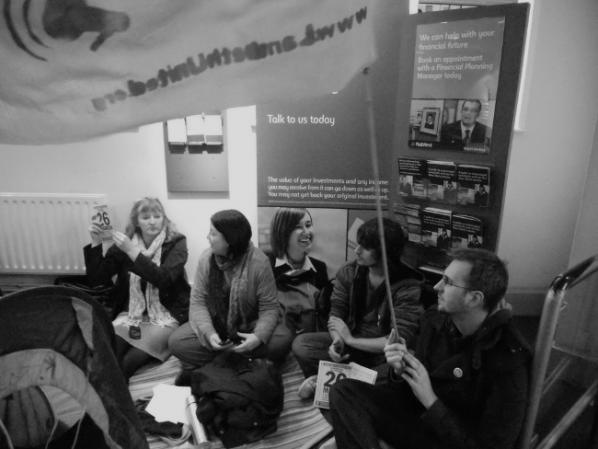
Do you think that UK Uncut’s own perceptions and its activism reflect the festival audience’s general interests and feelings on the matter, across the board?
AS: The participation of UK Uncut is confirmed, but the speaker is to be announced. Whilst some festival audience members may be sympathetic with UK Uncut’s perceptions and activism, others may not. Similarly, whilst members of the festival programming board may have sympathies with UK Uncut’s cause, the festival as such does not necessarily share the same cause with UK Uncut. The reason for inviting UK Uncut was their very successful work as a technology savvy protest movement, as well as their exploration of new forms of protest, particularly sit-ins involving poetry readings and the singing of songs. We are interested to find out more about how they use technology and music/sound in their cause. Presented in a panel with Jeremy Gilbert, Mark Fisher and Anthony Iles, we hope to show how their work sits within the incredible role music had and continues to have in social, political and economic protest.
MG: Nurse With Wound is headlining the festival and they are legendary in the underground music scene. Spanning a career of 30 years plus, under the curatorial guide of Stapleton who has seen NWW collaborate with a highly respected troop of free thinkers including David Tibet (Current 93), William Bennett (Whitehouse) and Andrew McKenzie (Hafler Trio). Many artists who have been working with technology and similar experimental genres, are influenced by those of industrial and avant garde music scene, such as Throbbing Gristle, Cabaret Voltaire, Virgin Prunes, This Heat and NWW, so it seems fitting to have them in the festival, with their peers and of course, an equally interesting selection of younger sound artists and musical explorers.
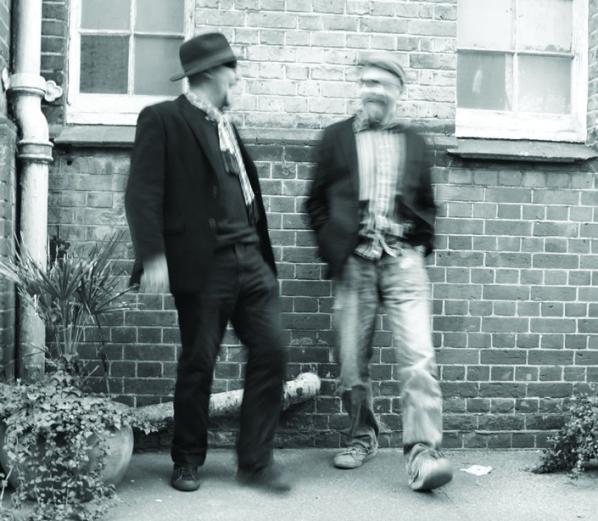
It may say seem like the perfect decision now, but how did you come to the idea of asking Nurse With Wound and what are the links with the other aspects of the festival?
AS: To have Nurse With Wound headlining our festival is a dream come true. Their achievements in anarchic, experimental, DIY, post-industrial music is unparalleled, and it is possible to find many of their approaches in the current new music produced by emerging musicians. This is something we hope to draw on in the rest of the festival.
At KOKO we will also present a newly commissioned live collaboration between Bruce Gilbert (ex-Wire) and Mika Vainio (ex-Pan Sonic). This opportunity to present new work came about though the direct continuation of an ongoing enquiry into collaborative creativity, as featured on one of the three conference panels. This is definitely also a strong theme in the work of Radian, the opening act at KOKO.
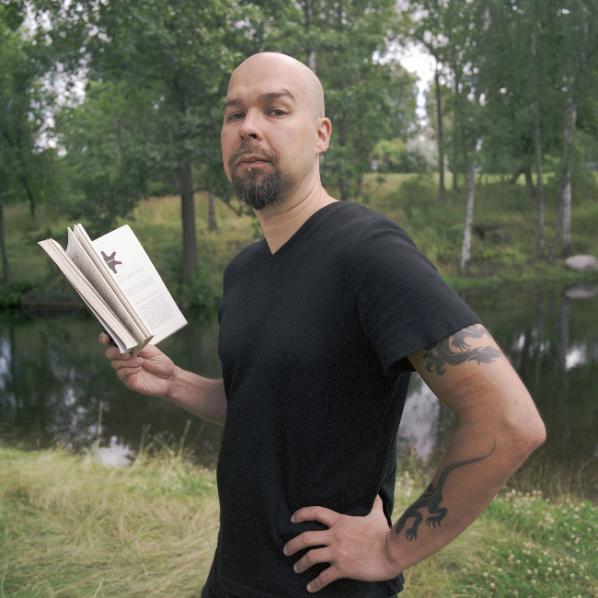
I’d urge anyone who is coming to see NWW at KOKO, to join us at the Roundhouse for the afternoon programme, particularly the conference, but also with the Open Platform stage, we hope to showcase some glimpses of the NWW legacy.
It may be worth mentioning the broadcast strand of the festival here too. Enabled by the Roundhouse Studio facilities and with creative input from Ed Baxter of Resonance104.4fm we are able to feed the festival back to the online domain for the first time. Throughout the afternoon of the 15th May, we will present a live web-zine, thereby leading an enquiry into the future of broadcasting. As part of this we will present three new pieces of work by the commissioned artists: Stefan Blomeier, VHS HEAD, and Liliane Lijn, the latter presenting an online adaptation of her Power Game project.
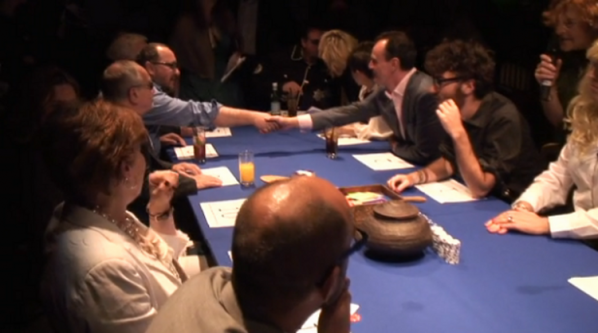
MG: This interesting development warrants investigation, not only because there is an an influx of new interest from a much larger informed and adventurous audience across the board but also because it represents an obvious, cultural dynamic at work. Reflecting a ‘real’ contemporary interest for something different to happen, beyond the remit of normative, art world restraints and its usual, hermetically sealed approaches. We will definitely be there ourselves. To experience what promises to be an engaging and critical conference, but also to explore and enjoy the other varied live events and projects.
The Conference – will bring together theorists, practitioners, activists and academics to address a challenging set of themes in 21st-century culture, featuring speakers including Matthew Herbert and Cecelia Wee: politics and protest; creativity and collaboration; digital futures and analogue survivals.
http://www.netaudiolondon.org/2011/strand/conference
Sound Art – In partnership with Call& Response Netaudio presents an event of 8-channel immersive audio-works. The dynamic and varied explorations of the nine prolific artists brought together by Call& Response highlights the vibrant and diverse field of contemporary sound art. Also there’s the Sonic Maze, an immersive series of sound art installations set in the Roundhouse Studios. http://www.netaudiolondon.org/2011/strand/sound-art
Broadcast – Using the format of a live webzine, Netaudio Broadcast will explore the future of broadcasting with a series of video and radio features. Netaudio Broadcast is co-curated with Ed Baxter of Resonance104.4fm. http://www.netaudiolondon.org/2011/strand/broadcast
Live Music – Starting at cafe OTO on 13th with Robert Piotrowicz (http://www.myspace.com/robertpiotrowicz) and Valerio Tricoli, continuing at Apiary with the runsounds hosted late night event; and the main live show of the festival, a rare live appearance from Steve Stapleton’s Nurse With Wound (http://en.wikipedia.org/wiki/Nurse_with_Wound), a special commission performance by Bruce Gilbert (ex-Wire) and Mika Vainio (ex-Pan Sonic) and Radian.
The 2011 Netaudio London festival supported by the National Lottery through Arts Council England and by the Austrian Cultural Forum London. It is presented in partnership with The Wire, ResonanceFM and Last.fm and supported by the Roundhouse and many more.